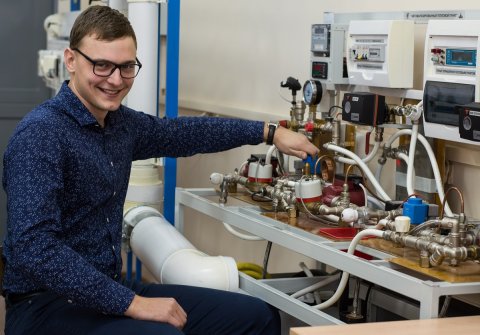As a result of a competitive selection among service members of student labor unions across Russia for the right to participate in international construction projects, the commander of South Ural State University’s Headquarter of Student Labor Unions, 5th year student of the Institute of Architecture and Construction, Semen Glushenko is to travel to the Ruppur Atomic Energy Station in South Asia.
As part of an international team, the student from the SUSU IAC Department of Construction Operations and Theory of Structures will take part in the construction of the Bangladeshi AES and preparation of as-built documentation, will learn about the process of equipment acceptance, and will learn the nuances of designer supervision over compliance with project documentation.
“This example demonstrates the scale of cooperation between SUSU and the largest enterprises in Russia and around the world, one of which is the Rosatom State Corporation. Practice-oriented teaching has been successfully used for a long time at the Institute of Architecture and Construction, which offers students the chance to make a significant contribution to construction of the largest objects around the world and earn their first professional experience,” noted the Director of the SUSU Institute of Architecture and Construction, Dmitriy Ulrikh.
The research and practical training foundation for the active implementation of project-based education in the Institute of Architecture and Construction is constant, close cooperation with leading design, construction, and manufacturing companies such as Betotek OOO, Legion-Proyekt OOO, UralAZproyekt OOO, Rosatom State Corporation, BASF (Germany, Russian Federation office), Knauf (Germany, Russian Federation office), Normet (Finland, Russian Federation office), Gruppa Magnezit, and many others. Close relationships have been established with leading universities in the USA, Germany, Finland, Hungary, the Czech Republic, China, and Bulgaria.
.jpg)
Dmitriy Ulrikh, Director of the SUSU Institute of Architecture and Construction.
“With the results of scientific research in which our students participated, the foundations of the Chelyabinsk-CITY building were calculated, and technologies for manufacturing and assembling metal constructions for the Cathedral of Christ the Savior (Moscow), the roof of the Luzhniki stadium (Moscow), and the roof of the Uralskaya Molniya (Chelyabink) were developed,” said Dmitriy Ulrikh. “The compositions and technologies for applying high-strength concrete for monolithic construction were developed and refined. The scientific problem of creating effective, large-scale, corrosion-resistant constructions made of layered plastics for industrial facilities has been solved. More than 100 patents for developed constructions and technological processes have been obtained.”
Alongside researchers from Chelyabinskgrazhdanproyekt State Design Institute and students of the Institute of the Architecture and Construction, a project for reconstructing the main building of SUSU was developed and executed, increasing the building height by 3 floors, and an 86-meter staged tower with a spire was built. Researchers from the IAC, students, and master’s students completed calculations on the frames of various famous objects across Chelyabinsk, among them: the multi-story buildings Fenix de Lux, Korol-Plaza, the Park-City hotel, the Manhattan residential building, the Yaroslavskiy residential building, and the Svyatogor residential building, and the engineering conditions of the load-bearing construction for Kinomax-Ural theater, Cuba shopping mall, Sinyegorye shopping mall, Nikitinskiy shopping mall, and the Kurchatov shopping mall were studied.
Egor Lazarevich, 4th year student of the Department of Building Materials and Products, is studying the possibility of using waste tailings from Gruppa Magnezit OAO (Satka) for the manufacture of heavy magnesia cement. The use of waste as construction materials will not just help reduce the ecological load on the surrounding area, create “eco-friendly” mining businesses, but also produce high-quality, competitive products.
.jpg)
“The Naslediye (Heritage) Research and Design Center was founded and actively operates in the Institute, the creative group of which completes orders within the partnership between SUSU and the Chelyabinsk archdiocese of the Russian Orthodox Church. The students study and certify monuments of architecture and develop projects for reconstructing and restoring churches and other culturally-significant objects under the guidance of experienced teaching staff. One more advantage of the Institute is the zone of elite training for students with high EGE (State Unified Exam) scores. In the High Construction School, students study professional disciplines and advanced English. Simultaneously, students of the Institute have the chance to participate in programs of inclusive education with universities in China – Zhejiang Ocean University and the Huazhong University of Science and Technology,” commented the IAC Director.
The main projects aimed at the international education space include the development of technology for herbal cleaning of manufacturing waste water to get rid of heavy metals, “green” construction under conditions of sharply continental climate, innovative engineering solutions for high-speed highways, magnesia materials for “green” construction, resource- and energy-saving technology for refractory materials based on waste of metallurgical industries, etc.
.jpg)
“The demand for our graduates has always exceeded the supply,” said the Director of the Institute of Architecture and Construction, Dmitriy Ulrikh. “From the third year of study, students understand their profession well and have a good understanding of where they will or can work. And in the fourth year, it is useless to search for an unemployed graduate. In this regard, of course, there are no issues with internship for students. It’s very nice that in such a difficult time, when finding work is a practically impossible task for many people, our alumni don’t face these issues.”
More than 270 specialists, bachelors, and masters earn their degrees and graduate from the Institute each year. They are all successfully employed and have good chances to create an excellent career for themselves. Graduates of the institute include: Chairman of the Chelyabinsk city Duma, S.I. Mosharov; Minister of Construction and Infrastructure of the Chelyabinsk region, V.A. Tupikin; the First Deputy Chairman of the Legislative Assembly of the Chelyabinsk region, General Director of PKO ChelSI OOO, Yu.R. Karlikanov; the Deputy Governor of the Chelyabinsk region, S.V. Shal; the Deputy Governor of the Chelyabinsk region, O.B. Klimov; General Director of Stroykom ZAO, A.A. Krikun; Director of Chelyabstalkonstructsia, V.V. Anzigitov; General Director of UralNIIstrom OOO, R. Ya. Akhtyamov, and many others.




